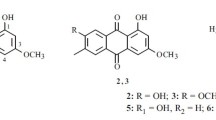Abstract
A new 7-methoxy-2-benzoxazolinone dimer named zeaoxazolinone (2), together with four known compounds; 9-Z-hexadecenoic acid (1), 6-methoxy-benzoxazolinone (3), gallic acid (4), and β-sitosterol-3-O-β-d-glucopyranoside (5) were isolated from Zea mays L. roots. The structural elucidation of isolated metabolites was established on the basis of UV, IR, 1D, 2D NMR, and MS spectral analyses. Compound 2 exhibited a potent antifungal activity against Aspergillus flavus, Fusarium oxysporum, and Candida albicans.


Similar content being viewed by others
References
Alam EA (2011) Evaluation of antioxidant and antibacterial activities of Egyptian Maydis stigma (Zea mays hairs) rich in some bioactive constituents. J Am Sci 7:727–729
Amer ME, Abou-Shoer MI, Abdel-Kader MS, El-Shaibany AMS, Abdel-Salam NA (2004) Alkaloids and flavone acyl glycosides from Acanthus arboreus. J Braz Chem Soc 15:262–266
D`Souzan L, Wahidulla S, Mishra PD (1997) Bisoxazolinone from the mangrove Acanthus illicifolius. Indian J Chem 36B:1079–1081
Gerothanassis IP, Exarchou V, Lagouri V, Troganis A, Tsimidou M, Boskou D (1998) Methodology for identification of phenolic acids in complex phenolic mixtures by high-resolution two-dimensional nuclear magnetic resonance: application to methanolic extracts of two Oregano species. J Agric Food Chem 46:4185–4192
Hossain MA, Islam A, Jolly YN, Ahsan MA (2006a) Diterpenes from the seeds of locally grown of Zea mays. Indian J Chem 45B:1774–1777
Hossain MA, Islam A, Jolly YN, Kabir MJ (2006b) A new flavanol glycoside from the seeds of Zea mays. Indian J Chem 45B:1319–1321
Huffaker A, Kaplan F, Vaughan MM, Dafoe NJ, Ni X, Rocca JR, Alborn HT, Teal PEA, Schmelz EA (2011) Novel acidic sesquiterpenoids constitute a dominant class of pathogen-induced phytoalexins in Maize. Plant Physiol 156:2082–2097
Ibrahim SRM, Mohamed GA, Al-Musayeib NM (2012) New Constituents from the Rhizomes of Egyptian Iris germanica L. Molecules 17:2587–2598
Kima S, Kubeca R, Musah RA (2006) Antibacterial and antifungal activity of sulfur-containing compounds from Petiveria alliacea L. J Ethnopharmacol 104:188–192
Nessa F, Ismail Z, Mohamed N (2012) Antimicrobial activities of extracts and flavonoid glycosides of corn silk (Zea mays L). Int J Biotechnol Wellness Ind 1:115–121
Niemeyer HM (2009) Hydroxamic acids derived from 2-hydroxy-2H-1,4-benzoxazin-3(4H)-one: key defense chemicals of cereals. J Agric Food Chem 57:1677–1696
Okuyama H, Enar D, Morita N (1997) Identification and characterization of a 9-cis-hexadecenoic acid cis–trans isomerase from a psychrotrophic bacterium, Pseudomonas sp. strain E-3. Proc NIPR Symp Polar Biol 10:153–162
Park S, Takano Y, Matsuura H, Yoshihara T (2004) Antifungal compounds from the root and root exudates of Zea mays. Biosci Biotechnol Biochem 68:1366–1368
Ramos-Escudero F, Munõz AM, Alvarado-Ortíz C, Alvarado A, Yáñez JA (2012) Purple corn (Zea mays L.) phenolic compounds profile and its assessment as an agent against oxidative stress in isolated mouse organs. J Med Food 15:206–215
Ren S, Liu Z, Ding X (2009) Isolation and identification of two novel flavones glycosides from corn silk (Stigma maydis). J Med Plants Res 3:1009–1015
Sicker D, Frey M, Schulz M, Gierl A (2000) Role of natural benzoxazinones in the survival strategies of plants. In: Kwang WJ (ed) International review of cytology—a survey of cell biology. Academic Press, London, pp 319–346
Sosa A, Rosa EL, Fusca MDR, Ruiz SO (1997) Flavonoids and saponins from styles and stigmas of Zea mays L. (Gramineae). Acta Farm Bonaerense 16:215–218
Suzuki R, Iijima M, Okada Y, Okuyama T (2007) Chemical constituents of the style of Zea mays L. with glycation inhibitory activity. Chem Pharm Bull 55:153–155
Acknowledgments
The authors are grateful to the ‘Research Center of the Female Scientific and Medical Colleges’, Deanship of Scientific Research, King Saud University for the financial support and to Dr. Volker Brecht (Nuclear Magnetics Resonance, Institut fuer Pharmazeutische Wissenschaften, Albert-Ludwigs-Universität Freiburg, Germany) for HRESIMS measurements.
Author information
Authors and Affiliations
Corresponding author
Electronic supplementary material
Below is the link to the electronic supplementary material.
Rights and permissions
About this article
Cite this article
Mohamed, G.A., Ibrahim, S.R.M., Abdelkader, M.S.A. et al. Zeaoxazolinone, a new antifungal agent from Zea mays roots. Med Chem Res 23, 4627–4630 (2014). https://doi.org/10.1007/s00044-014-1026-9
Received:
Accepted:
Published:
Issue Date:
DOI: https://doi.org/10.1007/s00044-014-1026-9




